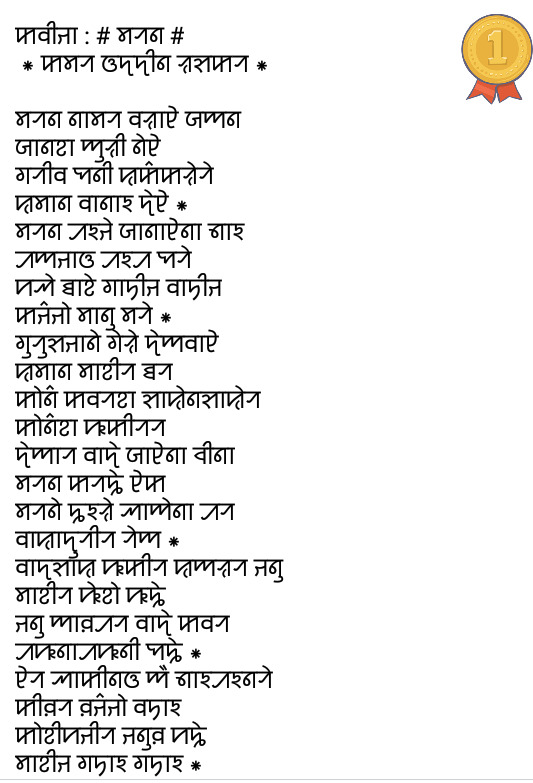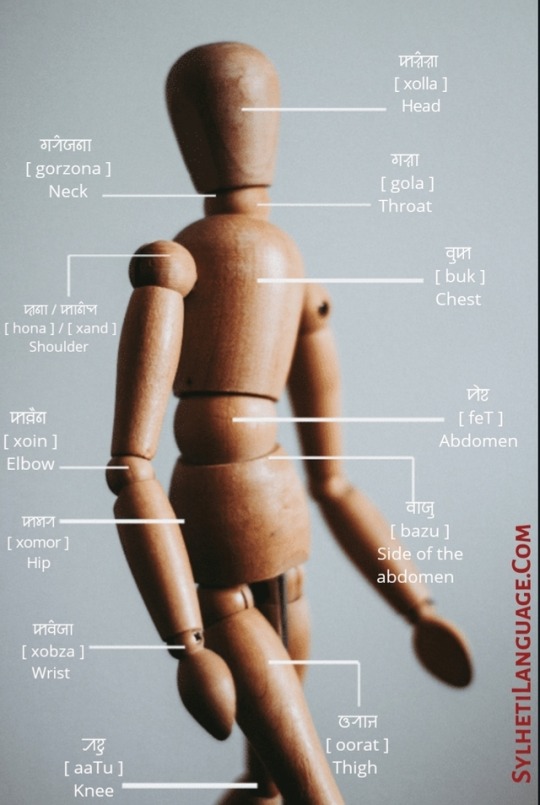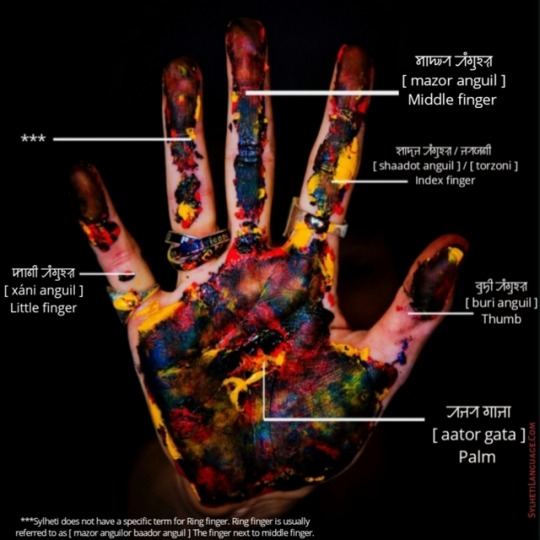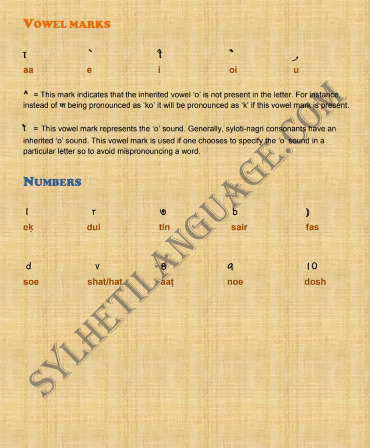Text

Please join us in congratulating the winner for the Sylheti Poetry Contest organized by the Sylheti Language Preservation project. Komor Uddin Laskar has won the award for his poem "Moron." Read his poem in the photo attached.
Selecting the winner was not an easy process. We've received many wonderful, unique, and fascinating poems to be considered for this award. We would like to thank everyone who participated in this contest and joined the effort in promoting the Sylheti language.
There will be other contests, so please keep an eye out for future announcements. We're also recruiting more enthusiastic and passionate volunteers for our team. If you're interested, send us a message for more information!
5 notes
·
View notes
Text
everyone who reblogs this post by February 21, 2020 will get a sylheti word written in syloti-nagri in their ask box. (must use tumblr from mobile app/site to view the script)
52 notes
·
View notes
Photo


SYLHETI POETRY CONTEST presented by Sylheti Language Preservation.
Contestants will be judged on:
Their proficiency in the Sylheti language.
The quality of the poem.
Poem’s relevance to the theme.
Points will be NOT be deducted for:
Spelling.
The quality of hand-writing.
If you have further questions, feel free to reach out to us!
15 notes
·
View notes
Photo





BODY PARTS IN SYLHETI
[ Disclaimer: Due to phonological differences among different regions, the pronunciation of some words may vary. ]
49 notes
·
View notes
Photo


GUIDE TO SYLOTI-NAGRI
Download the PDF here.
After the Syloti-Nagri script, the best way to represent Sylheti phonetics is by using the Latin script due to its flexibility and availability. ḳ ḍ ṭ ṛ - these letters/sounds are crucial for the Sylheti language; however, they’re not always available on every device. Therefore, we recommend using the following replacements for the most precise pronunciation and spelling.
ḳ = x ḍ = D (upper case D) ṭ = T (upper case T) ṛ = R (upper case R)
Example: Xene (Why)?, TanDa (cold), maTi (soil/ground), gaRi (car).
For words with different tones, we recommend using an accent mark or diacritic when writing in the Latin script. You can use: Acute accent mark ( ◌́ ) for a high tone, Macron line ( ◌̄ ) or double vowels (aa) for a low tone.
3 notes
·
View notes
Text
Sylheti Language: An Overview
Read this article in বাংলা
INTRODUCTION
Sylheti (also known as Siloti or Silothia) is an Indo-Aryan language and the native language of approximately 12 million people worldwide; Sylheti is primarily spoken in India and Bangladesh. In India, Sylheti is most commonly spoken in three of Assam’s districts (Cachar, Hailakandi, and Karimgonj ), with many speakers also in Meghalaya, Tripura, and Manipur. In Bangladesh, Sylheti speakers are found mostly in the districts of Sylhet, Sunamganj, Hobigonj, and Moulvibazar. Sylheti also boasts a large diasporic population, having established communities in the Middle East, Italy, Australia, among others, with the heaviest concentration of Sylheti speakers residing in the United States and the United Kingdom. About 95% of British Bangladeshis (more than half a million) are ethnically Sylheti.
FEATURES
Sylheti is unique from most other Indo-Aryan languages due to the presence of tone; Punjabi is another notable tonal language of the same branch. While there is no explicit proof of direct Tibeto-Burman influences on Sylheti, many attribute Sylheti’s tonal features to its Tibeto-Burman neighbors. Sylheti employs two tones: high and low. For example, “aTani” means “to shorten”, but when marked by a high tone it becomes “áTani”, meaning “to walk someone”. For more examples, check out Wikipedia’s Sylheti Language page.
Sylheti has a variety of dialects, with some sounding remarkably similar to Bangla while others differ significantly. Dialectical boundaries are drawn by region, but also by religion. Sylheti Muslims tend to use more borrowed words than Sylheti Hindus, drawing vocabulary from Hindi and Farsi. In general, Sylheti does borrow a considerable amount of vocabulary from Farsi as well as Bengali and Assamese.
SCRIPT
The Sylheti language has traditionally been written in the Syloti-Nagri or Sylheti Nagari script --a script closely related to the Kaithi script of Bihar. Syloti-Nagri matches the phonology of spoken Sylheti perfectly and has only 33 characters (5 vowels and 28 consonants), making it easier to learn compared to the Bengali-Assamese script. Historically, the simplicity and convenience of Syloti-Nagri made it popular among Sylheti people for everyday use.
The origin of the Syloti-Nagri script is hotly debated. Some claim that Afghans who lived in the region during Afghan rule introduced the foundations of the alphabet as some of the characters resemble letters found on older Afghan coins. Others believe that the writing system was brought by Shah Jalal during the 13th or 14th century due to the influence of Sufism in Muslim Sylheti literature. Still, others trace the script’s origin back five thousand years ago to the traces of Syloti-Nagri script in the Puranas.
HISTORY
Sylheti had been considered its own language for the longest time. However, following Bangladesh’s split from Pakistan in 1971, the government of Bangladesh reduced the status of Sylheti to simply a dialect of Bengali to promote a greater Bengali identity, and also heavily discouraged the use of Sylheti script. Consequently, the use of Sylheti has been in gradual decline since Sylheti speakers began using Bengali, the “prestige language”, in official settings due to government educational standards and the reverence of mainstream Bengali culture over minority cultures. Sylheti’s endangerment has been further pressed by the abandonment of the Sylheti script in schools, leaving the writing system on the verge of extinction.
Several campaigns have been launched to preserve the language and gain recognition for Sylheti’s language status. Some of the most notable campaigns were led during the mid-1970s to mid-1980s in London by BENTH (Bangladeshis’ Educational Needs in Tower Hamlets), an organization founded to address hardships and disadvantages suffered by London’s Bangladeshi community. However, with the collapse of BENTH in 1985, the fight for Sylheti’s recognition as a language was brought to a halt.
PRESENT DAY
An increasing number of people are gaining interest in the Sylheti language, largely due to Sylheti musicians and actors gaining traction in mainstream society while also producing entertainment in Sylheti. Research organizations have made old Sylheti literature more accessible and have also published modern Sylheti books in the Syloti-Nagri script. The script has been given more visibility in the public sphere as well. The Nagari Chattar is a sculpture in Sylhet, Bangladesh that includes letters from the Syloti-Nagari script carved into its sides. Sylheti has also grown more relevant in the modern world with the development of Syloti-Nagari keyboards and apps for mobile phones.
Although still considered a dialect by the Bangladeshi government, and erroneously identified as “Bengali” by many native Sylhetis around the world, the future of the Sylheti language is beginning to shine brighter as more people explore the language’s history and culture.
11 notes
·
View notes
Text
সিলেটি ভাষা: একটি সংক্ষিপ্ত বিবরণ
প্রবন্ধটি English এ পড়ুন।
সূচনা
সিলেটি ( ছিলটী বা সিলহেটি নামেও পরিচিত) একটি ইন্দো-আর্য পরিবারের ভাষা এবং বিশ্বব্যাপী প্রায় ১২ মিলিয়ন লোকের মাতৃভাষা; সিলেটি মূলত ভারত এবং বাংলাদেশের কথিত ভাষা । ভারতে সিলেটি আসামের তিনটি জেলা (কাছার, হাইলাকান্দি এবং করিমগঞ্জ) মধ্যে সর্বাধিক প্রচলিত । মেঘালয়, ত্রিপুরা এবং মণিপুর রাজ্যেরও অনেক অংশে সিলেটি ভাষী জনসংখ্যা রয়েছে। বাংলাদেশে সিলেটিভাষীরা প্রধানত সিলেট, সুনামগঞ্জ, হবিগঞ্জ এবং মৌলভীবাজার জেলার অধিবাসী । ভারত উপমহাদেশের বাহিরে সিলেটিভাষীরা মার্কিন যুক্তরাজ্য ও যুক্তরাষ্টে সর্বাধিক কেন্দ্রীভূত হলেও মধ্য প্রাচ্য, ইতালি, অস্ট্রেলীয়া সহ বিশ্বের আরো বিভিন্ন জায়গায় প্রতিষ্ঠিত সিলেটি সম্প্রদায় রয়েছে । প্রায় ৯৫ ভাগ ব্রিটিশ বাংলাদেশীরা (অর্ধ মিলিয়নেরও বেশি) জাতিগতভাবে সিলেটি ।
বৈশিষ্ট্য
স্বর বা টোনের উপস্থিতির কারণে অন্যান্য ইন্দো-আর্য ভাষা থেকে সিলেটি অনন্য; একই শাখার আর একটি উল্লেখযোগ্য টোনাল ভাষা হলো পাঞ্জাবি । যদিও সিলেটিতে তিব্বতি-বর্মী ভাষাগোত্রের প্রভাবের কোনো সুস্পষ্ট প্রমাণ পাওয়া যায়নি, অনেকে সিলেটির প্রতিবেশী তিব্বতি-বর্মী ভাষাগুলোকে সিলেটির এই বিশেষ বৈশিষ্টের কারণ মনে করেন। সিলেটি প্রধানত দুটি টোন বহন করে: উচ্চ এবং নিম্ন। উদাহরণস্বরূপ, "আটানী " এর অর্থ "সংক্ষিপ্ত করা", তবে উচ্চ টোন নিযুক্ত করা হলে এটি “আ’টানী " হয়ে যায়, যার অর্থ "কাউকে হাঁটানো"। আরও উদাহরণের জন্য, উইকিপিডিয়ায় সিলেটি ভাষার পৃষ্ঠাটি দেখুন।
সিলেটির বিভিন্ন উপভাষা রয়েছে যাদের কয়েকটির বাংলা ভাষার সাথে তুলনামূলকভাবে বেশি মিল রয়েছে, একই ভাবে কয়েকটি সিলেটি উপভাষা ও বাংলার মধ্যে উল্লেখযোগ্য পার্থক্য রয়েছে। ভাষাগত পার্থক্যের সীমানা শুধু অঞ্চল দ্বারাই আঁকা নয়, ধর্ম দ্বারাও। সিলেটি মুসলমানদের মধ্যে সিলেটি হিন্দুদের চেয়ে হিন্দি এবং ফারসি ভাষার শব্দভাণ্ডার থেকে ঋণ করা শব্দ ব্যবহার করার প্রবণতা বেশি দেখা যায় । সাধারণত , সিলেটি ভাষা ফারসি ভাষার পাশাপাশি বাঙালি ও অসমীয়া ভাষা থেকেও অনেক ঋণ শব্দ ব্যবহার করে।
লিপি
সিলেটি ভাষা ঐতিহ্যগতভাবে ছিলটি নাগরী বা সিলেটি নাগরী লিপিতে লিখিত হয়েছে - সিলেটি নাগরী বিহারের কৈথি লিপির সাথে নিবিড়ভাবে সম্পর্কিত একটি লিপি। সিলেটি-নাগরী কথ্য সিলেটির ব্যবহৃত ধ্বনির সঙ্গে পুরোপুরি সামজ্ঞস্যপূর্ণ । এই লিপির মাত্র ৩৩ টি অক্ষর (৫ টি স্বরবর্ণ এবং ২৮ ব্যঞ্জনবর্ণ) রয়েছে, যা একে বাংলা-অসমীয়া লিপির তুলনায় শিখতে সহজ করে তোলে। ঐতিহাসিকভাবে, সিলেটি-নাগরীর সরলতা এবং স্বাচ্ছন্দবোধ একে সিলেটি মানুষের কাছে দৈনন্দিন ব্যবহারের জন্য জনপ্রিয় করে তুলেছিল।
সিলেটি-নাগরী লিপিটির উৎস তীব্রভাবে বিতর্কিত। কেউ কেউ দাবি করেন যে আফগান শাসনামলে এই অঞ্চলে বসবাসকারী আফগানরা এই বর্ণমালার ভিত্তি প্রবর্তন করে কারণ কিছু বর্ণের চরিত্র প্রাচীন আফগান মুদ্রায় পাওয়া চিহ্নের অনুরূপ। আবার মুসলিম সিলেটি সাহিত্যে সুফিবাদের প্রভাবের কারণে অনেকে বিশ্বাস করেন যে, খ্রিষ্টপূর্ব ১৩ বা ১৪ শতকে শাহ জালাল এই লিপি ব্যবস্থা নিয়ে এসেছিলেন। কেউ কেউ আবার পাঁচ হাজার বছর পূর্বে রচিত পুরাণেও সিলেটি-নাগরী লিপির অস্তিত্ব খুঁজে পান।
ইতিহাস
সিলেটি দীর্ঘকাল যাবত তার নিজস্ব ভাষা হিসাবে বিবেচিত ছিল। তবে, ১৯৭১ সালে পাকিস্তান থেকে বাংলাদেশ বিভক্ত হবার পর বাংলাদেশ সরকার বৃহত্তর বাঙালি পরিচয় প্রতিষ্ঠার জন্য সিলেটির মর্যাদাক্ষয় করে সিলেটি ভাষাকে বাংলার একটি উপভাষা হিসেবে স্থান দেয় এবং সিলেটি লিপির ব্যবহারকে নিরুৎসাহিত করে। সরকারী শিক্ষাগত মান এবং সংখ্যালঘু সংস্কৃতির তুলনায় মূলধারার বাঙালি সংস্কৃতির মর্যাদার কারণে সিলেটি ভাষীরা বাংলা ভাষা তথা prestige language ব্যবহার করা শুরু করে। ফলস্বরূপ, সিলেটির ব্যবহার ক্রমশ হ্রাস পেতে থাকে। স্কুল ও অন্যান্য পরিবেশে সিলেটি লিপিকে পরিত্যাগের দরুন সিলেটি ভাষার ক্ষয় ও বিপন্নতা আরো জোরদার হয়।
ভাষা সংরক্ষণ এবং সিলেটির ভাষার স্বীকৃতি অর্জনের জন্য বেশ কয়েকটি প্রচারণা শুরু করা হয় । লন্ডনের বাংলাদেশী সম্প্রদায়ের যেসব সমস্যা ও অসুবিধাগুলি রয়েছে তার সমাধানের জন্য প্রতিষ্ঠিত সংস্থা BENTH (Bangladeshis’ Educational Needs in Tower Hamlets) দ্বারা ১৯৭০ দশকের মাঝামাঝি থেকে ১৯৮০ দশকের মাঝামাঝি সময়ে সবচেয়ে উল্লেখযোগ্য কয়েকটি প্রচারণার নেতৃত্ব দেওয়া হয়েছিল। ১৯৮৫ সালে BENTH এর পতনের সাথে সাথে, ভাষা হিসাবে সিলেটির স্বীকৃতি অর্জনের লড়াইও থমকে যায়।
আজকের সিলেটি
সিলেটি সংগীতশিল্পী এবং অভিনেতারা মূলধারার সমাজে সিলেটিতে বিনোদন উপস্থাপন করে অনেক জনপ্রিয়তা লাভ করেছেন এবং ক্রমবর্ধমান সংখ্যক মানুষ সিলেটি ভাষার প্রতি আগ্রহ অর্জন করছে। গবেষণা সংস্থাসমূহ প্রাচীন সিলেটি সাহিত্যকে জনসাধারণের হাতের নাগাড়ে এনে দিয়েছে এবং সিলেটি-নাগরী লিপিতে আধুনিক সিলেটি বই প্রকাশ করেছে। । নাগারি চত্ত্বর সিলেটের একটি ভাস্কর্য যাতে সিলেটি-নাগরী বর্ণগুলো খোদাই করা রয়েছে । মোবাইল ফোনে সিলেটি-নাগরী কীবোর্ড এবং অন্যান্য সিলেটি ভাষা সম্পর্কিত অ্যাপ্লিকেশনগুলির বিকাশের সঙ্গে সঙ্গে আধুনিক বিশ্বে দিন দিন সিলেটি ভাষা আরও প্রাসঙ্গিক হয়ে উঠছে।
যদিও সিলেটি ভাষা এখনও বাংলাদেশী সরকারের নিকট একটি উপভাষা হিসেবে বিবেচিত, এবং ভুলক্রমে বিশ্বজুড়ে অনেক স্থানীয় সিলেটবাসীর দ্বারা "বাঙালি" বলে চিহ্নিত , ধীরে ধীরে লোকেরা ভাষার ইতিহাস এবং সংস্কৃতি অন্বেষণ করায় সিলেটি ভাষার ভবিষ্যত ক্রমশ উজ্জ্বল হতে শুরু করেছে।
1 note
·
View note
Text
Why Should We Preserve the Sylheti Language?
Read this article in বাংলা
SYLHETI STORIES
--the lives where a language lives
*all names have been changed to protect the anonymity of those who have chosen to share their stories
BILAL
A son to Sylheti parents, Bilal was born in the United States and grew up speaking to his friends and neighbors in English. He was able to understand Sylheti but could speak no more than a few basic phrases and his parents pushed him to learn Bengali instead, with no success. At the turn of his teenage years, Bilal reflected on the loss of his culture and heritage with regret, hoping to rekindle a connection with his ethnic identity. Language was a natural first step to reclaiming lost ties, but he struggled to find a place to start, citing difficulties with even feeling a connection to the culture. “My parents watched movies in Bangla but I could never understand them. I thought learning the language would help me connect to my roots but I got discouraged a few days after I started. It was like learning a new language; the culture --it felt distant as well. It wasn’t like how I’ve seen my parents or my relatives live.” Bilal is now 29 and a father of two children. When asked if his children knew how to speak Sylheti, he replied, “How can I teach them a language I can’t speak?”
AMITA
Amita was born in Bangladesh to a middle-class Sylheti family in the middle of a non-Sylheti community. Growing up, she felt ashamed of her linguistic and cultural background to the point of masking her heritage. Amita refused to speak Sylheti in public so that she would not be identified as Sylheti. Even at home, Amita spoke a very “Banglified” Sylheti, inserting influence from the majority language (Bangla) into her home language. Presently, Amita is well aware of the history of her native tongue and finds pride in it. However, she is unable to speak Sylheti properly despite her desire to fully embrace the language. Years of suppressing her Sylheti culture has smothered her ability to speak the language she has learned to love, and now her children have inherited her same struggles when it comes to speaking their heritage language.
KHALED & EMA
Khaled and Ema may have been born in two different countries but they share the same story. Both belong to Sylheti-speaking families, but neither of them are able to speak Sylheti themselves. Both of them admit that their parents took the initiative to teach them Bengali from a young age --the assumption being that Bengali would help them appear sophisticated, better cultured, and well-educated. Their families view Sylheti as a low-class, vulgar language. Speaking fluent Bangla brings pride and confidence to those who come from an undervalued background. Consequently, Khaled and Ema suffer a disconnect from their heritage and shoulder the shame their families associate with Sylheti as a language and as a culture.
SYLHETI: A PAST & A FUTURE
--the fate of a minoritized language
Following the birth of Bangladesh as a nation, the country sought to emphasize unity between its citizens. Among the measures taken was the Bengali Language Implementation Act (1987) which established Bengali as the official language of Bangladesh. Not only did this solidify Bangla’s status as the lingua franca of the region --and as a language of the elite and the educated-- it also devalued the minority languages that natively reside in Bangladesh alongside Bengali. It is currently punishable by law to conduct official Bangladeshi matters with any language other than Bengali unless it is a government recognized matter that requires the use of a foreign language. From here is a ripple effect of oppression and silencing of one of Bengal’s largest native minoritized languages: Sylheti.
The culture that boasts of Bengali’s superiority and prestige is the same one that defames Sylheti as a lower-class “dialect” of Bengali in both Bangladesh and in India. Sylheti has been stripped of its status as a full-fledged language, contributing to the false idea that if Sylheti is merely a dialect of Bangla, Sylheti people are just a subclass of Bengali. Not only does this effect Sylhetis living in Bangladesh, but this also heavily affects Sylhetis living in India who are already alienated by the perception that they belong in Bangladesh instead of India. Failure to officially recognize Sylheti and its speakers has largely erased Sylheti cultural identity. Government offices, newspapers, and TV stations across the Bengal region regularly publish in Bengali and neglect Sylheti. Children also see this imbalance in their schools where Bangla is the language of the classroom. In place of the Sylheti script Sylheti children learn the Bengali writing system to write read and write Bangla, but also to read and write Sylheti (if they choose to communicate in Sylheti at all). The overall decline of the Sylheti language has been much more visible in West Bengal and Assam where Sylheti culture is often considered entirely foreign and seen as a Bangladeshi identity despite the fact that the Sylheti community is also native to parts of India. However, many Sylhetis on either side of the border claim Bengali heritage and speak Bengali at home in place of their parents’ language for the sake of assimilation and status within mainstream Bengali society.
The systematic erasure of Sylheti as a language has lead to its status as a minoritized language. Sylheti enjoys no legal privileges and receives little to no public recognition. Its speakers can barely find materials in Sylheti; people of Sylheti diaspora turn to Bengali as an alternative to Sylheti and face struggles as they’re mutually unintelligible. Sylheti script is also heavily endangered. While Sylheti largely remains as a domestic language among Sylheti communities, it still faces risks. Younger generations are beginning to lose Sylheti as they speak it less frequently than their parents and grandparents --many of them adopting a “Banglified” version if they do speak it. Still many have lost their ability to communicate in Sylheti altogether. As seen in the accounts above, the devaluation of Sylheti has also led to the deterioration of the Sylheti community identity, where Sylhetis feel invisible or ashamed of their heritage and feel compelled to separate themselves from the culture of their ancestors. Those that do choose to hang on to their cultures find it difficult to do so when there are no resources available and when so many of their neighbors discourage their choice to pursue knowledge on Sylheti.
However bleak Sylheti’s current situation looks, the language is resilient and still has the opportunity to thrive. Between local organizations advocating for the protection of Sylheti and a growing number of materials for Sylheti being introduced on the internet, Sylheti has the support and tools it needs to be properly recognized and properly taught. Our mission with the Sylheti Language Preservation Project is to compile and create materials to educate Sylhetis and non-Sylhetis alike on the Sylheti language. We hope to inspire Sylhetis to reclaim their language and heritage, and also to spread awareness of Sylheti as a valuable and unique language that deserves recognition on a local and global scale. Together we can ensure Sylheti is here to stay for current and future generations!
10 notes
·
View notes
Text
কেন সিলেটি ভাষাকে সংরক্ষণ করতে হবে?
প্রবন্ধটি English এ পড়ুন।
সিলেটি কাহিনী
--যে জীবনগুলোতে ভাষার বসবাস
*ব্যাক্তিগত প্রাইভেসী রক্ষার্থে প্রতিটি কাহিনীতে ছদ্মনাম ব্যবহৃত হয়েছে।
বিলাল
বিলালের জন্ম আমেরিকায় এক সিলেটি বাবা-মার ঘরে। শৈশব থেকেই বন্ধুবান্ধব ও প্রতিবেশীদের সঙ্গে ইংরেজীতে কথা বলে বড় হওয়ায় সে সিলেটি ভাষায় কথা বলাটা ঠিকমতো আয়ত্ত করতে পারেনি। অন্যদিকে ওর বাবা-মা কোনো ছোট বেলা থেকেই ওকে বাংলা শিখার জন্য চাপ দেন। নিজের সংস্কৃতি ও ঐতিহ্য হারানোর অনুতাপে সে তার কৈশোরের বছরগুলোতে শিকড়ের সম্পর্ককে পুনর্জ্জীবিত করার আশা করে। হারিয়ে যাওয়া সম্পর্ক স্থাপনের একটি স্বাভাব��ক প্রথম ধাপ ছিল ভাষা কিন্তু সেই প্রথম ধাপেই দেখা দিল প্রতিকূলতা। “আমার বাবা - মা বাংলায় সিনেমা দেখতেন, কিন্তু আমি ওসব কখনোই বুঝতে পারিনি। আমি ভেবেছিলাম যে ভাষাটা শিখলে হয়তো নিজের শিকড়ে ফিরে যেতে পারবো কিন্তু বাংলা শিখা শুরু করার কয়েকদিন পরই আমি উৎসাহ হারিয়ে ফেললাম। মনে হচ্ছিলো যেন আমি নতুন কোনো ভাষা শিখছি। এই সংস্কৃতিকেও আমার আপন মনে করতে পারলাম না। আমার বাবা-মা আত্মীয়স্বজনের সংস্কৃতি আর এই সংস্কৃতি এক ছিল না।” বিলালের বয়স এখন ২৯ বছর। সে দুই সন্তানের জনক। যখন জিজ্ঞাসা করা হলো তার সন্তানেরা সিলেটি ভাষায় কথা বলতে পারে কি না, সে উত্তর দিল, “ আমি নিজেই যে ভাষায় কথা বলতে পারি না, তা ওদেরকে কিভাবে শিখাবো?”
অমিতা
নন - সিলেটি প্রধান এলাকার এক মধ্যবিত্ত সিলেটি পরিবারে জন্ম গ্রহণ করে অমিতা। নিজের ভাষাগত ও সাংস্কৃতিক পরিচয়ের প্রতি প্রচন্ড এক লজ্জা নিয়েই ওর বড় হওয়া। যাতে অন্যরা তার সিলেটি পরিচয় জানতে না পারে সে জন্য সে লোকসমুক্ষে সিলেটি ভাষায় কথা বলতে অস্বীকৃতি জানায়। বাইরে সবসময় বাংলা বলার অভ্যাস প্রভাব বিস্তার করে বাড়িতে ও। যখন সে বাংলায় কথা বলতো, সে একধরণের banglafied সিলেটি ভাষা ব্যবহার করতো। আজ অমিতা তার মাতৃভাষার ইতিহাস নিয়ে জ্ঞাত এবং ভাষাগত পরিচয় নিয়ে গর্বিত। কিন্তু নিজের ভাষা কে সাগ্রহে গ্রহণ করার পর ও সে সিলেটি ভাষায় সঠিকভাবে কথা বলতে অক্ষম। এতগুলো বছর নিজের ভাষা ও সংস্কৃতিকে দমনের চেষ্টার পর সে আজ নতুন করে যে ভাষাকে ভালোবাসতে শিখেছে, নিজের অজান্তেই তার ভাষাজ্ঞানকে সে-ই তো নির্মূল করেছে। এখন অমিতার সন্তানকেও তার মতো জগাখিচুরি ভাষায় কথা বলার জটিলতায় ভোগতে হয়।
খালেদ ও ইমা
খালেদ ও ইমার জন্ম ভিন্ন ভিন্ন দেশে হলেও ওদের গল্পটা একই। দুজনই সিলেটি ভাষাভাষী পরিবারের অন্তর্গত কিন্তু দুজনের কেউই সিলেটি ভাষায় কথা বলতে পারে না। ওদের সঙ্গে কথা বললে জানা যায় যে ওদের ওদের বাবা-মা অল্প বয়স থেকেই ওদের বাংলা শিখানোর উদ্যোগ নিয়েছে- সন্তান যাতে পরিশীলিত, সুশিক্ষিত, ও উন্নতর সংস্কৃতির অধিকারী হয় সেই আশায়। উভয় পরিবারেই সিলেটিকে অমার্জিত ও গেঁয়ো ভাষা হিসেবে দেখা হয়। ফ্লুয়েন্ট বাংলায় কথা বলার দক্ষতা পরিবারে বয়ে আনে গর্ব ও অহংকার। বাংলাকে প্রধান্য দিতে গিয়ে আপন ভাষা ও সংস্কৃতির সঙ্গে দূরত্বের সৃষ্টি হয় তাদের। যে সুশীলতার ছোঁয়া খালেদ ও ইমার পরিবার দিতে চেয়ে ছিলেন, হিতের বিপরীতে সেটাই লজ্জার গ্লানি হয়ে আজ পীড়া দিচ্ছে তাদের।
সিলেটি : একটি অতীত ও একটি ভবিষ্যত
--সংখ্যালঘু ভাষাগুলোর ভাগ্য
স্বতন্ত্রজাতি হিসেবে ১৯৭১ সালে জন্মের পর থেকেই বাংলাদেশ জনগণের মধ্যে ঐক্য প্রতিষ্ঠার লক্ষে আপ্রাণ চেষ্টা করে। জাতিকে একতাবদ্ধ করার জন্য নেয়া বিভিন্ন পদক্ষেপের মধ্যে অন্যতম ছিল বাংলা ভাষা প্রচলন আইন (১৯৮৭) যা বাংলা ভাষাকে দেশের রাষ্ট্রভাষা হিসেবে প্রতিষ্টা করে। এই আইনের মাধ্যমে যে দেশের lingua franca হিসেবে বাংলার অবস্থান আরো মজবুত হয় তাই নয়, বরং বাংলা অভিজাত ও শিক্ষিত লোকের ভাষা হিসেবে পরিচিতি পায় যা দেশের আঞ্চলিক ও সংখ্যালঘু ভাষাগুলোকে পর্দার অন্তরালে ঠেলে দেয়। বর্তমানে বাংলাদেশে রাষ্ট্রীয় ও দাপ্তরিক বিষয়ে বাংলা ছাড়া অন্য কোনো ভাষার ব্যবহার আইনত দণ্ডনীয় অপরাধ- যদি না সেটি রাষ্ট্র স্বীকৃত কোনো বিষয় হয়ে থাকে যাতে বিদেশী ভাষা ব্যবহারের প্রয়োজন। এখন থেকেই শুরু হয় অবহেলার এক সূক্ষ্ম স্রোতধারা যা কোনঠাঁসা করেছে দেশের অন্যতম বৃহৎ স্থানীয় ভাষা, সিলেটিকে।
যে সংস্কৃতি বাংলা ভাষার শ্রেষ্ঠত্ব ও মর্যাদা নিয়ে অহংকার করে, সেই সংস্কৃতিই বাংলাদেশ ও ভারতে সিলেটিকে একটি নিম্নশ্রেণীর ‘উপভাষা’ বলে অপবাদ দেয়। সিলেটিকে তার পূর্ণাঙ্গ ভাষার অবস্থান থেকে বিচ্যুত করা হয়েছে আর প্রচার করা হয়েছে যে সিলেটি বাংলার একটি উপভাষা মাত্র। তাই সিলেটি যদি বাংলারই উপভাষা হয়, তবে সিলেটিরা বাঙালীজাতির একটি উপশ্রেণী। এই মিথ্যে ধারণার প্রভাব শুধু বাংলাদেশে বসবাসকারী সিলেটিদের উপরই নয়, বরং ভারতে বসবাসকারী লক্ষাধিক সিলেটিদের উপর ও পরে যাদের ইতিমধ্যে ‘তোমাদের ঠিকানা বাংলাদেশে, ভারতে নয়’ এমন ধারণা সাধারণ জনগণ থেকে আলাদা করে রেখেছে। রাষ্ট্রীয়ভাবে সিলেটি ভাষা ও সংস্কৃতিকে স্বীকৃতি দেয়ার ব্যর্থতা সিলেটি জাতিগত পরিচয়টিকেই মুছে ফেলেছে। বঙ্গের সর্বত্র সরকারি অফিস, আদালত, সংবাদ, এবং টিভি স্টেশনে হচ্ছে বাংলা প্রচারিত আর সিলেটি উপেক্ষিত। শ্রেণীকক্ষের ভাষাও বাংলা। সিলেটি লিপির জায়গায় সিলেটি বাচ্চারা বাংলা লিপিতে লিখতে ও পড়তে শিখছে। সেই বাংলা লিপিতেই চলে ওদের সিলেটি লেখা ও পড়া (সেটা যদি ওরা সিলেটি ভাষা ব্যবহার করতে আগ্রহী হয় তবে) সিলেটি ভাষার সামগ্রিক পতন পশ্চিমবঙ্গ ও আসামে আরো বেশি দৃশ্যমান যেখানে বহু সিলেটি সম্প্রদায় ভারতের অন্তর্গত হওয়া সত্ত্বেও সিলেটি সংস্কৃতিকে বাংলাদেশী সংস্কৃতি হিসেবে বিবেচনা করা হয়। সীমান্তের উভয় পাশেই অনেক সিলেটি বাঙালি ঐতিহ্য ও পরিচয় দাবি করে ও মূলধারার বাঙালি সমাজে সামাজিক মর্যাদা ও অবস্থানের জন্য পিতামাতার ভাষার পরিবর্তে বাংলা ভাষায় কথা বলে।
সুসম্মদ্ধভাবে সিলেটিকে একটি পূর্ণাঙ্গ ভাষার অবস্থান থেকে মুছে ফেলার কারণে সিলেটি আজ এই প্রান্তিক অবস্থায় উপমিত হয়েছে । সিলেটি কোনো আইনত সুবিধা ভোগ করে না এবং জনসম্মুখেও স্বীকৃতি পায় না। সিলেটি বংশোদ্ভুত লোকেরা সিলেটি ভাষা শিখার জন্য পর্যাপ্ত সামগ্রী না পেয়ে বিকল্প হিসেবে বাংলাকে বেছে নেয় এবং সমস্যার মুখোমুখি হয় যেহেতু উভয় ভাষা পরস্পর অবোধগম্য। সিলেটি লিপিও আজ মারাত্মকভাবে বিপন্ন। যদিও অধিকাংশ সিলেটি সম্প্রদায়ের মধ্যে সিলেটি এখনো একটি পারিবারিক ভাষা হিসেবে বর্তমান, ঝুঁকি রয়ে গেছে। নতুন প্রজন্মগুলো সিলেটি হারাতে বসেছে কারণ তাদের মধ্যে সিলেটি বলার প্রবণতা তাদের বাবা-মা ও বয়োবৃদ্ধদের চেয়ে কম। অনেকেই আবার সিলেটি ভাষায় কথা বলতে গেলে একটি banglafied ভার্শনে কথা বলছে। এরই মধ্যে অনেকে সিলেটিতে কথা বলার সম্পূর্ণ ক্ষমতা হারিয়ে ফেলেছে। উপরের স্বীকৃতিগুলোতে দেখা যায় যে সিলেটি ভাষার অবমূল্যায়ন সিলেটি সংস্কৃতির অবক্ষয়ে রূপ নিয়েছে যেখানে সিলেটিরা নিজেদের ঐতিহ্যের প্রতি লজ্জিত এবং পূর্বপুরুষের সংস্কৃতি থেকে নিজেদের আলাদা করার প্রয়োজনীতা বোধ করে। গুটি কয়েকজন যদিও নিজেদের শিকড়কে আঁকড়ে ধরার সিদ্ধান্ত নেয়, সিলেটি ভাষার জ্ঞান অর্জনের জন্য প্রয়োজনীয় সামগ্রীর ও আশেপাশের মানুষের কাছ থেকে উৎসাহের অভাবে অনেক প্রতিকূলতার মুখোমুখি হয়।
সিলেটির বর্তমান অবস্থা যতই বিবর্ণ দেখাক না কেন, ভাষাটি এখনো অটল ও স্থিতিশীল পায়ে দাঁড়িয়ে আছে এবং এর অবস্থার পরিবর্তনেরও সুযোগ রয়েছে। সিলেটি ভাষা সুরক্ষার জন্য স্থানীয় সংস্থাগুলোর নিরন্তর প্রচেষ্টা ও ক্রমবর্ধমান সংখ্যক সামগ্রীর উপস্থিতি আশার সঞ্চার করে। যথাযতভাবে স্বীকৃত ও সঠিকভাবে শিখানোর জন্য সিলেটি ভাষার প্রয়োনীয় সমর্থন ও সরঞ্জাম রয়েছে। Sylheti Language Preservation প্রকল্পে আমাদের মিশন হচ্ছে বিভিন্ন সামগ্রী সংকলন ও তৈরী করে সিলেটি এবং নন-সিলেটি নির্বিশেষে সবাইকে সিলেটি ভাষা সম্পর্কে শিক্ষিত করা। আমরা আশা করি আমাদের কাজ সিলেটিদের নিজ ভাষা ও ঐতিহ্য পুনরুদ্ধার করতে অনুপ্রাণিত করবে এবং সিলেটি একটি মূল্যবান ও একক ভাষা হিসেবে স্থানীয় ও আন্তর্জাতিক মঞ্চে স্বীকৃতি পাবে। সকলের সহযোগিতায় আমরা নিশ্চিত করতে পারি যে সিলেটি ভাষা বর্তমান ও ভবিষ্যৎ প্রজন্মের জন্য আছে ও থাকবে।
2 notes
·
View notes